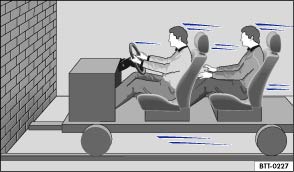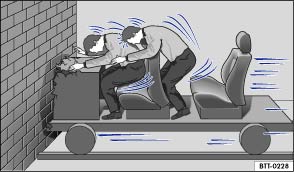Volkswagen Polo Owners Manual: Frontal collisions and the laws of physics

Fig. 45 Unbelted occupants in a vehicle heading for a brick wall

Fig. 46 Unbelted occupants in a vehicle striking a brick wall
 First read and observe the introductory information
and safety warnings
First read and observe the introductory information
and safety warnings
The physical principles involved in a frontal collision are relatively simple. As soon as the vehicle is in motion , both the moving vehicle and its passengers gain kinetic energy.
The higher the vehicle speed and the heavier the weight of the vehicle, the greater the amount of energy that will have to be released in the event of an accident.
However, the most significant factor is the speed of the vehicle. If the speed doubles from approximately 25 km/h (15 mph) to approximately 50 km/h (31 mph), for example, the kinetic energy increases by a factor of four.
The amount of kinetic energy depends on the speed of the vehicle and the weight of the vehicle and passengers. The higher the speed and the heavier the weight, the greater the amount of energy that will be released in the event of an accident.
Passengers not wearing seat belts are not connected to the vehicle. In the event of a frontal collision they will continue to move forwards at the same speed at which the vehicle was travelling before impact, until something stops them. Because the passengers in our example are not restrained by seat belts, the entire amount of kinetic energy will only be released at the point of impact against the wall .
Even at speeds of approximately 30 km/h (19 mph) to approximately 50 km/h (31 mph), the forces acting on bodies in a collision can easily exceed one tonne (1,000 kg). These forces are even greater at higher speeds.
This example applies not only to frontal collisions, but to all accidents and collisions.
 Warning lamp
Warning lamp
Fig. 44 Warning lamp in the instrument
cluster
First read and observe the introductory information
and safety warnings
Lights up or flashes
Possible cause
Solution ...
 What happens to vehicle occupants who have not fastened their seat belts
What happens to vehicle occupants who have not fastened their seat belts
Fig. 47 An unbelted driver is thrown forwards
Fig. 48 The unbelted rear passenger is
thrown forwards, hitting the belted driver
First read and observe the introductory information
and safety ...
Other materials:
Vehicle lifting points
Fig. 150 Lifting points at front for the
lifting platform or vehicle jack
Fig. 151 Lifting points at rear for the
lifting platform or vehicle jack
First read and observe the introductory information
and safety warningsThe vehicle may only be lifted at the points shown in
the illustration ...
Opening and closing the bonnet
Fig. 134 A: release lever in the footwell
on the driver side. B: release lever on the bonnet
Fig. 135 C: holder for the bonnet stay
in the lock carrier. D: bonnet secured with the bonnet stay
First read and observe the introductory information
and safety warningsOpening the bonnet
Ensu ...
Battery Charger -VAS5903- Device Description
WARNING
Risk of injury. Follow all Warnings and Safety
Precautions. Refer to
→ Chapter „Warnings and Safety Precautions“.
WARNING ...
